Monday Poster Session
Category: Liver
P2460 - Cocaine and Bactrim: A Double Whammy Liver Insult
Monday, October 23, 2023
10:30 AM - 4:15 PM PT
Location: Exhibit Hall

Has Audio

Christopher J. Costa, MD
University of Connecticut Health Center
Farmington, CT
Presenting Author(s)
Christopher J. Costa, MD1, Olivia W. Brooks, MD2, Emily Van Antwerp, DO3, Rahul Mutneja, MD4
1University of Connecticut Health Center, Farmington, CT; 2University of Connecticut Health Center, Hartford, CT; 3University of Connecticut Health, Farmington, CT; 4Trinity Health of New England, St. Francis Hospital, Hartford, CT
Introduction: We present a case of presumed cocaine and TMP-SMX-induced liver injury in a hepatocellular pattern in an immunocompetent patient.
Case Description/Methods: A 50-year-old male with a history of nephrolithiasis and recreational cocaine use presented to the emergency department with urinary urgency, frequency, and dark urine. One week prior the patient had completed a course of trimethoprim-sulfamethoxazole (TMP-SMX) for seven days for right arm cellulitis. He was hemodynamically stable and afebrile. Labs remarkable for leukocytosis to 21.1, BUN/Cr 54/5.9, AST >10000, ALT >5000, ALP 84, CPK 1141 and PT/INR 24.2/2. Urine toxicology positive for cocaine. He denied alcohol use. CT imaging showed diffuse hypodensity of the liver suggesting fatty infiltration. HIV, CMV, EBV, HSF, HBV, HAV and HCV were negative; ANA positive at 1:160 (speckled pattern). Anti-SMA and AMA serologies were normal. He received intravenous fluids. Course included anuric renal injury, with eventual recovery. Liver enzymes downtrended and by discharge, ALT 1027 and AST 109.
Discussion: TMP-SMX is well tolerated in immunocompetent patients, with adverse reactions cited at 6-8%. Adverse events are often seen in patients with immune compromise. Emerging evidence indicates TMP-SMX causes liver injury via toxic metabolites, resulting in a cholestatic or mixed hepatocellular/cholestatic pattern. Severe hepatotoxicity is rare in immunocompetent patients, with few cases occurring in patients without hepatic disease. Cocaine causes centrilobular hepatocellular injury due to toxic metabolites of P450 degradation. Injury is seen within 1-2 days of heavy cocaine use and resolves over 1-2 weeks. In this patient, it is presumed that cocaine use perpetuated liver injury with the introduction of TMP-SMX explaining the hepatocellular pattern of injury which is unusual for TMP-SMX-induced liver injury.
The presence of equivocal immune markers, elevated CPK and hepatocellular pattern suggests a synergistic effect of cocaine and TMP-SMX. Literature review is unyielding of cases of cocaine and TMP-SMX causing a dual mechanism of liver injury. Much like previously reported cases of TMP-SMX or cocaine-indued liver injury alone, cessation of the agent and supportive care led to improvement of enzymatic abnormalities. TMP-SMX can potentially act with other hepatotoxins to cause severe adverse effects. Providers should be aware of a patient’s social history and consider other antibiotic options besides TMP-SMX if cocaine use is positive.
Disclosures:
Christopher J. Costa, MD1, Olivia W. Brooks, MD2, Emily Van Antwerp, DO3, Rahul Mutneja, MD4. P2460 - Cocaine and Bactrim: A Double Whammy Liver Insult, ACG 2023 Annual Scientific Meeting Abstracts. Vancouver, BC, Canada: American College of Gastroenterology.
1University of Connecticut Health Center, Farmington, CT; 2University of Connecticut Health Center, Hartford, CT; 3University of Connecticut Health, Farmington, CT; 4Trinity Health of New England, St. Francis Hospital, Hartford, CT
Introduction: We present a case of presumed cocaine and TMP-SMX-induced liver injury in a hepatocellular pattern in an immunocompetent patient.
Case Description/Methods: A 50-year-old male with a history of nephrolithiasis and recreational cocaine use presented to the emergency department with urinary urgency, frequency, and dark urine. One week prior the patient had completed a course of trimethoprim-sulfamethoxazole (TMP-SMX) for seven days for right arm cellulitis. He was hemodynamically stable and afebrile. Labs remarkable for leukocytosis to 21.1, BUN/Cr 54/5.9, AST >10000, ALT >5000, ALP 84, CPK 1141 and PT/INR 24.2/2. Urine toxicology positive for cocaine. He denied alcohol use. CT imaging showed diffuse hypodensity of the liver suggesting fatty infiltration. HIV, CMV, EBV, HSF, HBV, HAV and HCV were negative; ANA positive at 1:160 (speckled pattern). Anti-SMA and AMA serologies were normal. He received intravenous fluids. Course included anuric renal injury, with eventual recovery. Liver enzymes downtrended and by discharge, ALT 1027 and AST 109.
Discussion: TMP-SMX is well tolerated in immunocompetent patients, with adverse reactions cited at 6-8%. Adverse events are often seen in patients with immune compromise. Emerging evidence indicates TMP-SMX causes liver injury via toxic metabolites, resulting in a cholestatic or mixed hepatocellular/cholestatic pattern. Severe hepatotoxicity is rare in immunocompetent patients, with few cases occurring in patients without hepatic disease. Cocaine causes centrilobular hepatocellular injury due to toxic metabolites of P450 degradation. Injury is seen within 1-2 days of heavy cocaine use and resolves over 1-2 weeks. In this patient, it is presumed that cocaine use perpetuated liver injury with the introduction of TMP-SMX explaining the hepatocellular pattern of injury which is unusual for TMP-SMX-induced liver injury.
The presence of equivocal immune markers, elevated CPK and hepatocellular pattern suggests a synergistic effect of cocaine and TMP-SMX. Literature review is unyielding of cases of cocaine and TMP-SMX causing a dual mechanism of liver injury. Much like previously reported cases of TMP-SMX or cocaine-indued liver injury alone, cessation of the agent and supportive care led to improvement of enzymatic abnormalities. TMP-SMX can potentially act with other hepatotoxins to cause severe adverse effects. Providers should be aware of a patient’s social history and consider other antibiotic options besides TMP-SMX if cocaine use is positive.
Disclosures:
Christopher Costa indicated no relevant financial relationships.
Olivia Brooks indicated no relevant financial relationships.
Emily Van Antwerp indicated no relevant financial relationships.
Rahul Mutneja indicated no relevant financial relationships.
Christopher J. Costa, MD1, Olivia W. Brooks, MD2, Emily Van Antwerp, DO3, Rahul Mutneja, MD4. P2460 - Cocaine and Bactrim: A Double Whammy Liver Insult, ACG 2023 Annual Scientific Meeting Abstracts. Vancouver, BC, Canada: American College of Gastroenterology.
